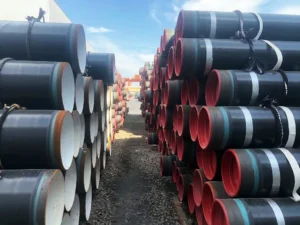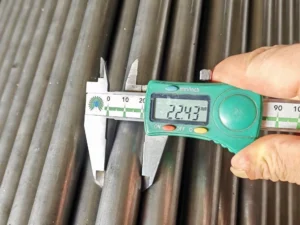Introduction
A steel pipe specification is key, and the most common standards are Schedule 20 and Schedule 40.
These represent how thick the walls of a pipe are, as well as how much pressure it can bear. These two aspects are crucial in selecting the correct steel pipe for a given purpose.
What is a Pipe Schedule?
You may get confused and wonder what a pipe’s ” schedule” is. The thickness of a pipe’s walls is its pipe schedule. It’s not measured in inches or any other unit like that, just a unit-less number.
This number tells you how thick the walls of the pipe are. The higher the schedule number, the wider the walls of the pipe.
Pipes of the same size can also have differing pipe schedules. Each pipe of the same size can have a different wall thickness.
As a result, each pipe in the other pipe schedules has various features and uses. The wall thickness influences the use of Schedule 20 vs Schedule 40 pipes in different applications.
Pipe Schedule 20
Schedule 20 steel pipes have thinner walls than most other types of pipes. These pipes’ thin walls allow them to withstand mild pressure and weight, making them suitable for Low-pressure jobs like residential plumbing. They are also sometimes used in industries for low-duty applications.
Pipe Schedule 40
Schedule 40 steel pipes have thick walls. Their schedule number is higher, so their walls are thicker than schedule 20.
The Schedule 40 pipe wall thickness gives them a more sturdy structure. It enhances their strength and durability. This is why a sch 40 pipe can withstand high pressures and temperatures. These pipes are used for industrial or commercial jobs. Learn more about Schedule 40 Steel Pipe.
Schedule 20 vs. Schedule 40
Schedule 20 and Schedule 40 steel pipes have different wall thicknesses, which affect all their other characteristics.
These characteristics include their pressure and temperature ratings, cost, installation, and applications.
So, let’s compare Schedule 20 and Schedule 40 pipes to see which one is better.

Weight and Wall Thickness
Schedule 20 is lightweight and has thinner walls. Schedule 40 weighs heavier because of its thick walls.
Temperature and Operating Pressure
Schedule 20 pipes are more suitable for lower-pressure and mild-temperature uses. In contrast, Schedule 40 pipes can bear higher pressure and extreme temperature conditions.
Strength and Durability
Schedule 20 pipes are durable enough for their intended application.
However, Schedule 40 pipes are a better option for heavy-duty usage. They are highly durable and robust, making them more suitable for heavy-duty use.
Cost and Installation
Schedule 20 is usually more cost-effective. It is easier to handle during installation due to its thin walls and lightweight.
Schedule 40 pipes may be slightly more expensive due to their thicker walls, but their thicker walls offer greater strength and durability.
Applications
Schedule 20 pipe is generally used in low-pressure applications, such as residential plumbing, light-duty industrial processes, and specific agricultural systems.
Schedule 40 pipe is widely used in industrial processing, including water distribution systems, high-pressure irrigation, and oil and gas transportation.
These differences make it clear that both pipes are different.
Due to its durability, a Schedule 40 pipe may be better than its Schedule 20 counterpart. However, it is also costly, and such high durability can be useless in some applications.
A Schedule 20 pipe is the most cost-effective and suitable choice in such cases.
A Guide For Selecting a Suitable Pipe Schedule
Many things need consideration when selecting a pipe schedule for any application. So, choosing the appropriate pipe schedule can be confusing.
Deciding which is better, Schedule 20 vs Schedule 40, can be confusing. Therefore, the guide below will help you make the best decision.
Operating Pressure:
Before buying a pipe, check the pressure rating needed for the application. Schedule 20 pipes will suffice for low-pressure ratings, while high-pressure applications would require a schedule 40 pipe.
Temperature:
Consider the temperature range that will be exposed to the pipe. Both pipes have certain temperature limits they can bear.
Schedule 40 pipes can withstand higher temperatures because of their thick walls and durability.
Meanwhile, 20 pipes will suffice for milder temperature applications.
Application Type:
Consider whether the application involves heavy-duty or light-duty usage. Schedule 20 pipe is more suited for residential use.
In contrast, sch 40 pipe is preferred for industrial and commercial use.
Cost and Budget:
Consider the budget and cost-effectiveness of the pipe.
Schedule 20 pipes are generally a more cost-effective option. They are easier to handle during installation because they are lightweight.
While Schedule 40 may be more costly. But, the higher upfront cost comes with the added benefits of greater strength and longevity. All this helps reduce long-term maintenance expenses.
Conclusion
In short, both Schedule 20 and Schedule 40 steel pipes are great.
Steel pipes, in general, are immensely important in many industries. Both Schedule 20 and Schedule 40 pipes have their significance and suitable applications. And none is better than the other. It all comes down to the nature of the application they are used for.
Suppose you want to use a pipe in mild-pressure applications where the temperature is not extreme.
In that case, schedule 20 is a good and cost-effective option. Meanwhile, the sch 40 pipe will better suit higher pressure uses where extreme temperature is used. Both options are incredible; it depends on how you want to use them.
If you want heavy-duty pipe that is stronger and more durable, Schedule 80 pipe is a better choice. It has thicker walls than Schedule 40 pipe and is therefore stronger and more durable. Check out the detailed comparison of Schedule 40 and Schedule 80 Pipe.
To choose durable pipe materials, please look for UNIASEN and contact UNIASEN experts to help you choose the pipe materials suitable for your project.

